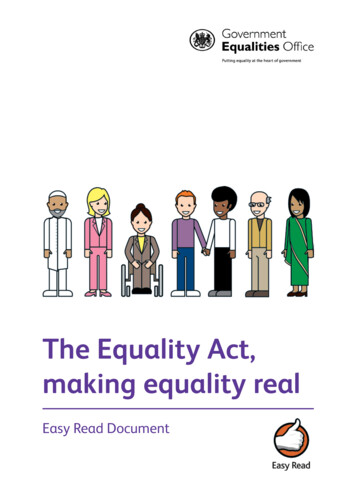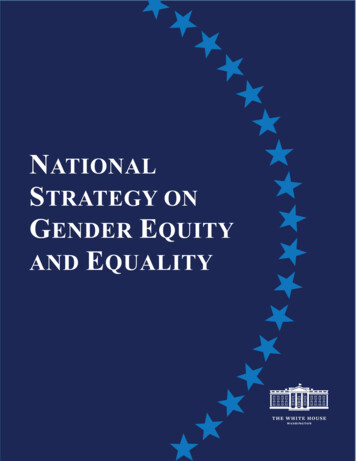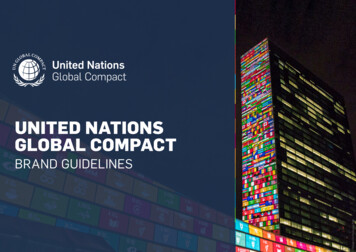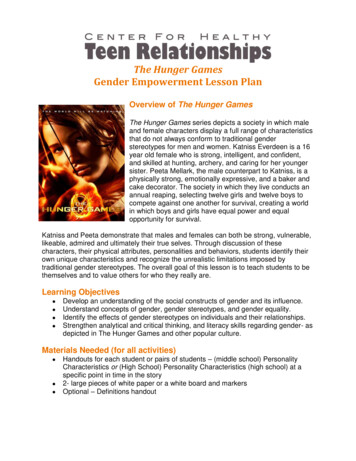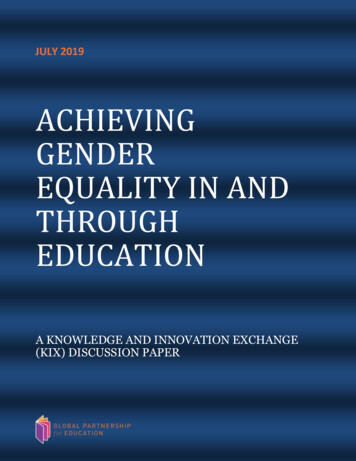
Transcription
JULY 2019ACHIEVINGGENDEREQUALITY IN ANDTHROUGHEDUCATIONA KNOWLEDGE AND INNOVATION EXCHANGE(KIX) DISCUSSION PAPER
Achieving Gender Equality In And Through EducationAcknowledgmentsThis paper was written by Elaine Unterhalter, independent consultant and professor of education andinternational development at University College, London, with inputs from Colleen Howell and JennyParkes, under the guidance of Jane Davies, Senior Education Specialist and Thematic Lead for GenderEquality at the GPE Secretariat.The inputs and feedback of the following individuals who reviewed this paper are gratefullyacknowledged: Nora Fyles, Christina Kwauk, Anna Bertmar Khan, Martha Muhwezi, Dana Schmidt, ClioDintilhac, Albert Motivans, Joyce Tepu, Venance N. Manori, Adeline Rasmata Ouedraogo, Jeanne Kopieu,Scholastique Mpengekeze, Alice Nindorera, Nhull Mugas, Aida Orgocka, Lucia Fry, Magdalene Lagu, SiljeSkeie, Sanaullah Panezai, Yolande Miller-Grandvaux, Matilda Branson, and Yona Nestel.In addition, we would like to acknowledge Nora Fyles of UNGEI for allowing us to organize consultationsessions to gather feedback on this paper during the GRESP regional workshops which were held inNairobi, Kenya in November 2018. Through these consultations, representatives from Zimbabwe, SomaliaFederal Government, and Puntland provided useful feedback on the paper.2
Achieving Gender Equality in and through EducationTable of ContentsExecutive Summary . 61. The importance of gender equality in and through education. 72. Paper development and consultation process . . 103. Challenges to achieving gender equality in and through education . 10Challenges faced by girls and boys in access, participation and learning .10Challenges within education systems .13Challenges in political, social and economic structures .154. How GPE supports gender equality in and through education . 195. Global public goods for gender and girls’ education: frameworks, research, data, tools, capacity andinnovation . 27Frameworks . 27Funding streams. 28Research . 29Data . 30Tools . 31Networks, convening and coordination mechanisms. 34Innovations . 366. Gaps in global goods . 33Project vs systems approaches 38Enabling environment in context .34Critical gasps in global goods 357. Potential investment areas . 39Broad thematic areas for investment . 45Specific examples of investment areas . 47Bibliograhy .50Annex A. GPE fact sheet on gender equality . 60GPE’s Gender Equality Policy and Strategy . 60Key results . 61Annex B. Global and regional frameworks . 63Global frameworks . 63Regional frameworks . 66Annex C. Countries in GPE for which there are peer-reviewed studies (2007-2018) in the ERIC databaseon effective interventions identified by Sperling & Winthrop (2015) . 683
Achieving Gender Equality in and through EducationA note on the KIX consultation processThe Global Partnership for Education’s Knowledge and Innovation Exchange (KIX) thematic funding willsupport global and regional initiatives that use knowledge exchange, evidence and innovation to helpdeveloping countries solve critical educational challenges. It will support: Capacity development and knowledge exchange among developing countries: activities thatstrengthen national capacity through peer review and exchange, creation of learning modules anddiagnostic tools, and face-to-face exchangeEvidence and evaluation: activities that aim to consolidate and/or extend knowledge about how toimprove educational outcomes and national education systemsInnovation pilots: piloting of approaches, methods, tools or products that solve persistenteducational challengesInvestments will be guided by the priorities of developing country partners and allocated through acompetitive process managed by an independent grant agent. Knowledge products, innovation pilots, andrelated tools developed through KIX funding will be shared through the Learning Exchange to amplify theiruptake.The purpose of this paper is to describe the current landscape in gender equality in education and sparkdiscussion and debate around potential areas for KIX investment. The paper is part of a series of discussionpapers, drafted to support the engagement and consultation of developing country partners and technicalexperts in the initial design of the GPE Knowledge and Innovation Exchange.4
Achieving Gender Equality in and through EducationAcronyms and ICEFUSAIDAfrican UnionCampaign for Female EducationCampaign for Popular EducationConvention on the Elimination of All Forms of Discrimination Against WomenContinental Education Strategy for AfricaInternational Centre for Girls’ and Women’s Education in AfricaCommission on the Status of WomenDeveloping Country PartnerU.K. Department for International DevelopmentDemographic and Health Surveyseducation cannot waiteducation management information systemsEducation Resources Information Centereducation sector planeducation sector program implementation grantForum for African Women Educationalistsfragile and conflict-affected countriesGroup of SevenGirls’ Education ChallengeGlobal Education MonitoringGender Equality Policy and Strategy 2016-2020Global Partnership for Educationgender parity indexGlobal and Regional ActivitiesGuidance for Developing Gender-Responsive Education Sector PlansKnowledge and Innovation Exchangelocal education groupMultiple Indicator Cluster Surveynon-governmental organizationsocioeconomic statusSustainable Development Goalschool-related gender-based violencetransitional educational planUnited NationsUnited Nations Educational, Scientific and Cultural OrganizationUnited Nations Girls’ Education InitiativeUnited Nations Children’s FundU.S. Agency for International Development5
Achieving Gender Equality in and through EducationKey TermsGender: The socially constructed roles, behaviors, activities and attributes that a given societyconsiders appropriate for men and women.*Gender Equality: The equal rights, responsibilities and opportunities of women, men, girls and boys,and equal power to shape their own lives and contribute to society.†Gender Equity: Included in the broader idea of gender equality, fairness and justice regardingbenefits and needs of women/girls and men/boys.†Gender Equality In And Through Education: Gender equality is present in the education system interms of access, learning and opportunities for girls and boys, and also in the content and delivery ofthe education, so that learners leave school and contribute to a more equitable society.Gender-Responsive: Informed by an awareness of the effects of gender norms, roles, and relationsas they impact education, and taking measures to actively reduce those effects that pose barriers togender equality†* UNESCO 2013.† GPE, Gender Equality Policy and Strategy 2016-2020.Executive SummaryThe importance of gender equality in and through educationAchieving gender equality in and through education is at the heart of the human rights agenda, and thekey to achieving the transformational 2030 Agenda for Sustainable Development. Global trends areincreasingly recognizing the intrinsic and extrinsic needs for investing in girls’ education, especially foradolescent girls, including in situations affected by fragility and conflict. Educating girls delivers a rippleeffect that not only benefits the girls themselves but also makes their families, communities and countrieshealthier, safer and more prosperous.According to the Global Partnership for Education’s Gender Equality Policy and Strategy 2016-2020(GEPS), achieving gender equality refers to the “equal rights, responsibilities, and opportunities of women,men, girls, and boys, and equal power to shape their own lives and contribute to society.”1 Achievinggender equality in and through education requires systemwide institutional change in the way policiesand plans are developed to ensure no one is left behind.Gender equality is a key cross-cutting theme in the Sustainable Development Goals (SDGs), as articulatedin the education goal (SDG 4), and central to the achievement of other SDGs, including ending poverty(SDG 1), enhancing health and well-being (SDG 3), supporting gender equality and women’s rights (SDG5), establishing decent work (SDG 8) and promoting peaceful and inclusive societies (SDG 16).1GPE, Gender Equality Policy and Strategy 2016-2020 (Washington, DC: GPE, 2016b), 5.6
Achieving Gender Equality in and through EducationAchieving gender equality in and through education requires developing equitable institutions thatgenerate policies, budgets and plans that enable all to succeed, regardless of whether they happen tohave been born male or female. This requires paying attention to the institutional arrangements,management structures, social norms, relationship dynamics and political economy issues that shapeeducation, and addressing gender-related disadvantages that deliver different outcomes for girls andboys, women and men.Challenges to achieving gender equality in and through educationWhile globally the number of out-of-school girls and boys of primary and secondary school age is virtuallythe same (131.7 million girls and 131.3 million boys),2 gender differences manifest differently in differentregions. Girls are more likely than boys to be out of school in Sub-Saharan Africa, North Africa and SouthAsia, where many GPE developing country partners (DCPs) are located. Even if girls are enrolled in school,they face gender-based challenges with access, progression, participation and learning outcomes thatoriginate both inside the school system and in the broader context in which the school is located. Thesechallenges represent a key barrier to achieving gender equality in and through education.Gender inequality is also a facet of the high dropout rates at primary and secondary levels, particularly ofgirls in many countries as well as boys in some countries. Gender intersects with other inequalities of race,ethnicity, class, disability and location to create education exclusion. Inequalities can also be embeddedin aspects of the education system itself, even if these are less easily seen: Curriculum, learning materialsteaching pedagogy, teacher education, management, administration, assessment, and monitoring andevaluation processes may all perpetuate hidden gender bias. Prejudice and discrimination can becometaken-for-granted everyday approaches unless there are opportunities for critical evaluation andreflection. Targeted policies, practices and research are needed to change these processes and assurethat the education system promotes gender-equitable experiences for all, both in and through schooling.Three specific challenges for building education systems that are more gender-responsive are highlighted: Challenges faced by girls and boys in access, participation and learning, and the need for a holisticapproach to achieve gender equalityChallenges within education systems, including the need to connect interventions withsystemwide reform, changing multiple levels of the system, and connecting across differentministries, implemented through gender-responsive education sector planningChallenges in addressing political and cultural structures, social and cultural norms, and how toconceptualize gender in a way that leads to institutional changeHow the Global Partnership for Education supports gender equality in and through educationThe Global Partnership for Education (GPE) invests heavily in education sector planning, providingdeveloping country partners grants of up to US 500,000 to prepare education sector plans (ESPs) basedon evidence and data. Once these plans are endorsed, GPE offers countries large-scale education sectorprogram implementation grants (ESPIGs) of up to a maximum of US 100 million. At the country level, GPEsupports the achievement of gender equality in education through its quality assurance process, which2UIS, “One in Five Children, Adolescents and Youth Is Out of School,” Fact sheet no. 48, February 20187
Achieving Gender Equality in and through Educationaims to ensure that ESPs and proposals for ESPIGs align with broader sector financing priorities and GPE’svision and strategic objectives.GPE recognizes that a transformative approach to gender equality in education is needed, one that goesbeyond simply focusing on expanding girls’ education and takes in all aspects of the education system.Achieving gender equality is a core principle of GPE’s strategic plan, GPE 2020. The GEPS highlights thecentrality of gender-responsiveness as a core priority throughout the work of GPE, to increase genderequality in access, participation and learning achievement for all girls and boys; improve gender equalityin education systems; to strengthen gender equality in education sector legal frameworks, policy andplanning processes; and to ensure robust execution of commitment to gender equality across thepartnership. GPE’s results framework has two indicators specific to gender parity, and a third countrylevel objective assesses how ESPs address gender equality and equity more broadly.In addition to its country-level grants supporting development and implementation of quality ESPs, GPEis further strengthening gender results through a strategic partnership with the United Nations Girls’Education Initiative (UNGEI), which seeks to build Developing Country partner (DCP) awareness forgender-responsive education sector planning together with other technical partners. GPE has also workedwith the World Bank to research a number of key gender-related issues, including child-marriage,economic benefits of investing in girls’ education and the connections between investments in schoolhealth and education and gender equality outcomes.The gender equality thematic area of GPE’s new Knowledge and Innovation Exchange (KIX) mechanismwill provide a vehicle for accelerating implementation of the GEPS and achievement of GPE 2020.Global goods and innovations in gender equality in and through educationFor the purposes of this paper, global goods are understood here to be “institutions, mechanisms andoutcomes that provide near universal benefits, reach across borders and extend across generations”:3that is, tools, products and approaches—including data, assessment tools, standards and researchoutcomes—that, once developed as the outcome of one particular intervention, can be adapted to createa tool or approach that is applicable, with appropriate customization, to other contexts.4A range of global goods already exist for supporting gender equality in and through education: There is an extensive architecture of global policy frameworks, including the SustainableDevelopment Goals, Education 2030 and regional strategies in Africa, Asia, and among theCommonwealth and Group of Seven (G-7) countries.Funding streams have grown over the past 10 years, particularly with regard to girls’ education.There has been an expansion of research on interventions, and four rigorous reviews of literature.3UNESCO/Global Education Monitoring Report. “Fulfilling Our Collective Responsibilities: Financing Global Goods in Education.”Policy Paper 34, UNESCO/Global Education Monitoring Report, Paris, 2018.4 The International Commission on Financing Global Education Opportunity. The learning generation: Investing in education fora changing world. Washington DC: Education Commission, 2016.8
Achieving Gender Equality in and through Education Some extensive data sets exist, including those by UNESCO, national education managementinformation system (EMIS) databases, household surveys, learning assessments andnongovernmental organization (NGO) studies.A wide selection of tools has been generated, including GPE’s tools to help countries developESPs, tools for monitoring the SDGs, school-level gender scorecards, and various tools relating togender and work in conflict or humanitarian disasters.There are some global and regional networking, convening and coordinating mechanisms, suchas UNGEI, the Forum for African Women Educationalists (FAWE), the Gender & Inclusion inEducation (GENIE) regional coordination group for West and Central Africa, the African UnionInternational Centre for Girls and Women Education in Africa (AU/CIEFFA and the Africa NetworkCampaign on Education For All (ANCEFA).There have been some innovations in achieving gender equality addressing the disparity of accessand quality of girls’ education worldwide. In GPE’s context, successful innovation is defined as thesuccessful exploitation of a product, process, strategy or approach that alters the effectiveness ofeducation systems.5Gaps in available global goodsTwo overarching gaps in available global goods stand out. First, the approach taken to date has mostlyaddressed the issues of girls’ schooling or gender inequality in education in a piecemeal way rather thanstrategically and holistically. There are evidence gaps in understanding how education systems need toadapt to support interventions targeted at improving girls’ education and gender equality mosteffectively. Second, there is little research on how such targeted interventions for improving genderequality results may in turn be either facilitated or constrained by features of an education system in agiven context. This knowledge gap applies to all areas of education system reform: in demand and supplyside investments, including curriculum change, teacher education and support, and styles ofmanagement, or community engagement. Institutional and individual capacity limitations, politicaleconomy aspects and other contextual factors all play a part in whether gender-targeted activities willdeliver sustainable results at scale or fail to achieve their potential impact.Key gaps in global goods are identified in five areas:1. Knowledge/EvidenceThere is limited evidence-based analysis looking into the results of packages of interventions and“what works” in particular contexts, including those affected by fragility and conflict. There is alack of research on many GPE countries, and a need for analysis on how gender intersects withother dimensions of marginalization. Understanding of the formation of masculinities and its linkswith interventions around girls’ education is needed, and the development of indicators formeasuring gender equality rather than gender parity more narrowly is necessary. Case studies ofwhat different countries have done to address common themes, including cases of working acrosssectors to leverage results would be useful.5GPE, “Knowledge and Innovation Exchange,” Board paper BOD/2017/12 DOC 09, December 2017b.9
Achieving Gender Equality in and through Education2. ToolsExisting tools are useful, but they need to be understood in relation to system-building, not asdiscrete tools. Similarly, existing tools for education sector analysis, planning, budgeting, scenariomodeling and management need to be enhanced to better reflect gender equality concerns.3. NetworksThere are limited convening opportunities for policymakers, practitioners and researchcommunities to come together within and between countries to share their experiences of howgender equality in education may be hampered or facilitated in their own contexts, and to reflecton links between gender interventions and broader education reform.4. InnovationsWhile a number of valuable innovations are noted, a deeper understanding of how these have orhave not been institutionalized into the education system to bring about sustainable changewould be beneficial.5. Capacity and peer learningAt both the international and national levels, there is a limited number of staff with genderexpertise, with limited opportunities for peer learning and experience sharing inregional/multicountry forums and workshops.Potential investment areasGPE investments in achieving gender equality in and through education through the KIX mechanism needto prioritize efforts to address the challenges identified, leverage the existing global goods and considerthe most strategic and practical ways of filling some of these key gaps in global goods.Through the consultation process, opportunities emerged for which global goods funded by KIX could becritical. These opportunities also align with the aims of GPE 2020 and the GEPS. These investments canaccelerate implementation of the GEPS’s six output areas and help meet the demands of developingcountry partners seeking to deliver tangible gender equality results at the country level.Four areas for global goods investment emerge as key for addressing the challenges and gaps, in line withGPE’s focus on system-level change, unique comparative advantage linking global, regional and nationalactors, and advancing GPE’s implementation of its Gender Equality Policy and Strategy through KIX goingforward: On topics where there is potential for a geographic focus, there is a need to open opportunitiesfor peer learning exchange, development of tools and capacity building for gender-responsivesector analysis, planning, budgeting and implementation.On topics where there is a sufficient evidence base, there is a need to build capacity throughsystematic knowledge exchange, capacity development and learning exchange.On topics where there are some examples of solutions but more synthesis is needed to develop asolid evidence base, it is necessary to build evidence and evaluation of what works.On topics where there is a need for new thinking and solutions, investigation into innovations andtheir links to system-level reform are needed.10
Achieving Gender Equality in and through EducationBased on the broad directions proposed above, some specific areas link to this comparative advantageand respond to the feedback received during the consultation process: Consideration of a geographic lens to support peer learning and exchange, development of toolsand capacity building for gender-responsive education sector analysis, planning, budgeting,implementation and monitoring for results, with a particular focus on Sub-Saharan Africa, 6where GPE’s 2018 results report shows that achieving gender parity in completion rates atprimary and secondary school remains challenging.Annual global conference to support development of a community of practice and knowledgesharing around gender equality in education system reform, centered on the global south. 7Noting the tendency for gender equality issues to be marginalized at academic conferences,where the focus tends to be on identities rather than on policy and practice, and lack ofopportunities for networking on gender, an annual global conference to support development ofa community of practice and knowledge sharing on gender equality in and through educationwould be helpful.Analytical work on gender-responsiveness of education systems.8 As noted above, much workto date has focused on what works for girls’ education, but less on how different specificinterventions are linked to/lead to system-level reform for sustainable results. Analytical workis needed to ask the critical questions on why countries should invest in one area and not another,whether targeted or mainstreamed activities are more effective, and what packages ofinvestments generate the most powerful results on gender equality. How does change happen,and what are the success factors and relevant contextual elements? What generalizableconclusions can be drawn? Research undertaken in health system reform and in theorganizational change domain can provide useful models to suggest avenues for enquiry.Development of metrics for measuring gender equality in and through education.9 As noted inthe paper, the Convention on the Elimination of All Forms of Discrimination Against Women(CEDAW) General Comment 36 provides the normative framework for focusing beyond parity innumbers to a broader focus on gender equality, not only in education but also through education.However, while the indexes for measuring gender parity are well established and sexdisaggregated data are increasingly collected in most EMIS as a matter of routine, much workremains to be done to develop a common metric for measuring gender equality.Cross-sectoral work to strengthen gender equality results. 10 Recognizing the challengereferenced above that many barriers to gender equality in education lie outside the educationsystem, this investment stream would build on GPE work with the health sector and provideopportunities for reflection on successful examples of working across sectors to tacklemultifaceted gender-related issues such as child marriage, school-related gender-based violence(SRGBV), early pregnancy, HIV/AIDS and empowerment.Identification of innovations with potential for scale-up linked to system-level reform. 11 Asnoted in the text, often innovations may be useful and produce benefits for specific beneficiariesin niche contexts, but they may remain as stand-alone interventions that are not scaled up orinstitutionalized into the system. This investment stream would seek (a) to identify promising6Links to Gender Equality Policy and Strategy (GEPS) aim 3, output 3.Links to GEPS aim 4.8 Links to GEPS aim 2.9 Links to GEPS aims 2 and 3.10 Links to GEPS aims 1, 2 and 3; output 4.11 Links to GEPS aims 1 and 2.711
Achieving Gender Equality in and through Educationinnovations in high-impact thematic areas, such as shifting gender dynamics in relations betweenboys and girls, promoting girls’ empowerment and leadership, and school-related gender-basedviolence; (b) examine their suitability for scale-up and institutionalization; and (c) identify caseswhere such innovations have been scaled up and incorporated into national and provincialpolicy/planning/budgeting, and what affected the success of such reforms.Building inter-linkages and synergies between the funding streams, other KIX thematic areas and GPE’scountry-facing work will be essential for optimal impact. Investments can be prioritized and sequenced,based on availability of funding and partner interest/capacity to implement.1. The importance of gender equality in and through educationAccording to the Gender Equality Policy and Strategy 2016-2020, achieving gender equality refers to the“equal rights, responsibilities, and opportunities of women, men, girls, and boys, and equal power toshape their own lives and contribute to society.”12 Gender equality benefits women and men, girls andboys, and should be of concern to all. Achieving gender equality in and through education requiressystemwide institutional change in the way policies and plans are developed to ensure no one is leftbehind. These processes require attention to the structures, norms and relationships that shape educationdisadvantage for the people in the system. These disadvantages may manifest differently for girls, boys,women and men. Gender equality requires processes for building and sustaining equalities between girlsand boys, women and men, within and beyond schooling.Gender equality also refers to the outcome of equal rights a
Achieving gender equality is a core principle of GPE [s strategic plan, GPE 2020. The GEPS highlights the centrality of gender-responsiveness as a core priority throughout the work of GPE, to increase gender equality in access, participation and learning achievement for all girls and boys; improve gender equality


